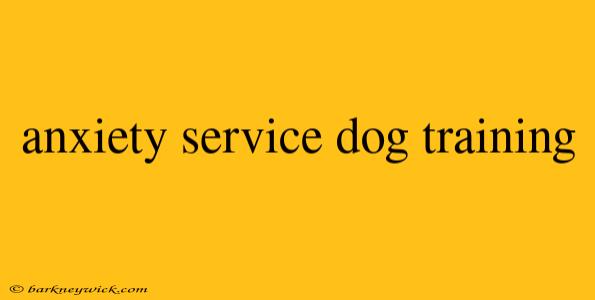Understanding the Role of Anxiety Service Dogs
Anxiety service dogs are specially trained companions who provide invaluable support to individuals living with anxiety disorders. They're not just pets; they're highly skilled partners trained to detect and respond to specific anxiety triggers, offering a range of support mechanisms.
What Tasks Can Anxiety Service Dogs Perform?
Anxiety service dogs undergo rigorous training to master a variety of tasks, including:
- Providing Deep Pressure Therapy: Applying gentle pressure through physical contact, such as leaning against their handler, can reduce anxiety and promote feelings of calm.
- Interrupting Anxiety Episodes: They can be trained to interrupt panic attacks by distracting their handler or retrieving specific comfort items.
- Retrieving Medication: They can learn to retrieve medication containers, ensuring timely access to needed treatments.
- Providing Grounding Techniques: Some dogs can be trained to guide their handlers through grounding exercises, helping them regain focus and control during anxious moments.
- Acting as a Barrier: They can create a physical barrier between their handler and potential triggers, offering a sense of security.
Choosing the Right Dog for Anxiety Service Dog Training
Finding the perfect dog for anxiety service dog training is crucial. While many breeds are suitable, key qualities to look for include:
- Temperament: Calm, patient, and gentle dogs with a strong desire to please.
- Trainability: Dogs that are highly responsive to training and eager to learn new commands.
- Health: A strong, healthy dog that can handle the demands of service work.
Stages of Anxiety Service Dog Training
Training an anxiety service dog is a comprehensive process that involves several stages:
1. Basic Obedience Training: This stage lays the foundation for all other training by establishing strong communication and obedience.
2. Task Training: This stage focuses on teaching specific tasks to address anxiety-related needs, like deep pressure therapy or medication retrieval.
3. Public Access Training: This stage ensures the dog can behave appropriately in public settings, adhering to local laws and regulations.
4. Ongoing Maintenance: Continuous practice and reinforcement are crucial to maintain the dog's skills and ensure their continued effectiveness.
Finding a Qualified Trainer
Choosing a qualified anxiety service dog trainer is vital. Look for trainers with:
- Experience: Years of experience working with anxiety service dogs.
- Credentials: Certifications from reputable organizations.
- References: Testimonials from previous clients.
- Positive Reinforcement Methods: Trainers who utilize humane and effective training techniques.
Benefits of an Anxiety Service Dog
The benefits of an anxiety service dog are profound and can significantly enhance an individual's quality of life:
- Increased Independence: Provides greater autonomy and confidence for managing anxiety symptoms.
- Reduced Anxiety: Offers comfort, reassurance, and support during stressful situations.
- Improved Social Engagement: Facilitates greater participation in social activities.
- Enhanced Sense of Safety: Creates a sense of security and companionship, helping alleviate feelings of isolation.
Conclusion
Anxiety service dogs are invaluable companions that empower individuals with anxiety disorders to live more fulfilling lives. By understanding the training process, finding the right dog, and working with a qualified trainer, you can embark on a journey towards greater independence, well-being, and a brighter future.
